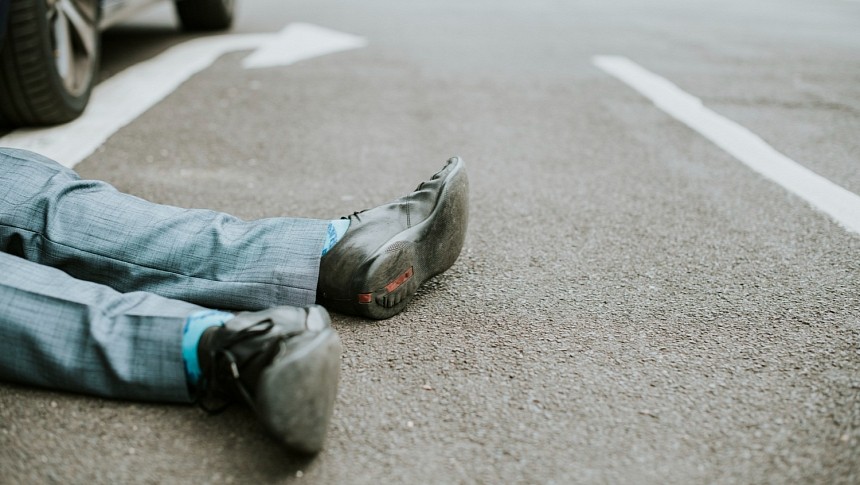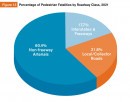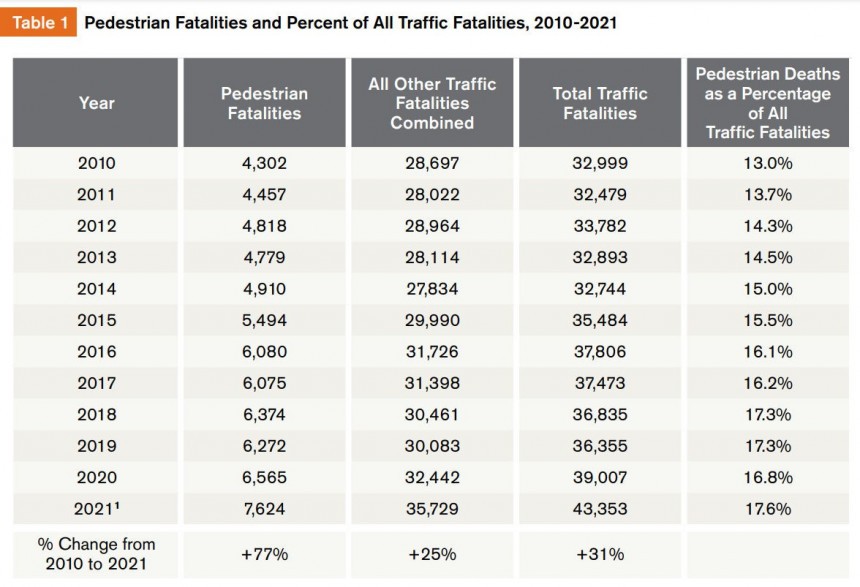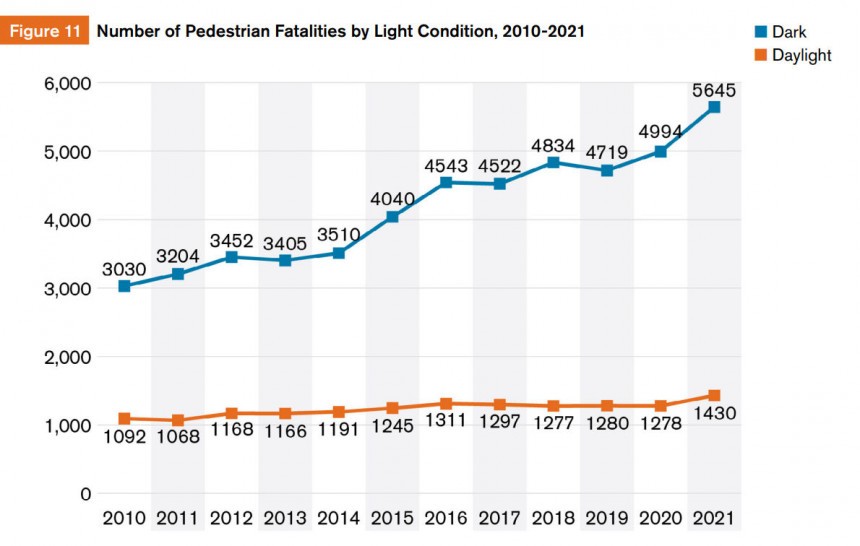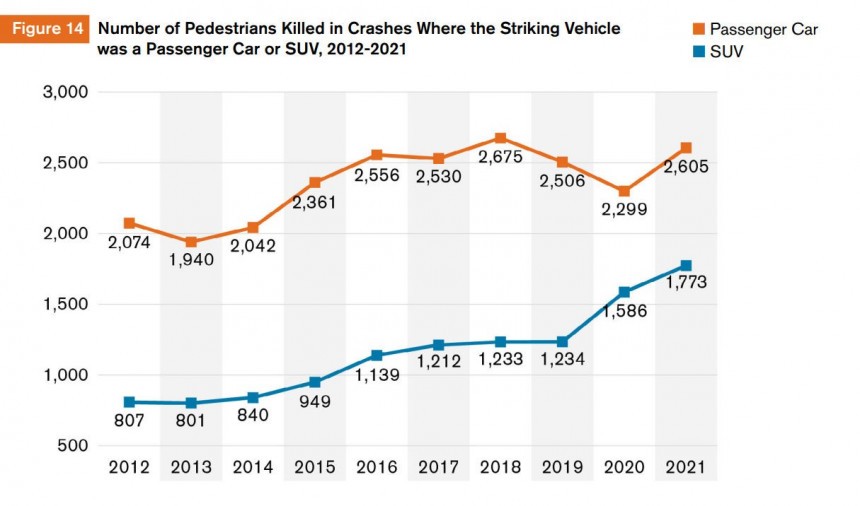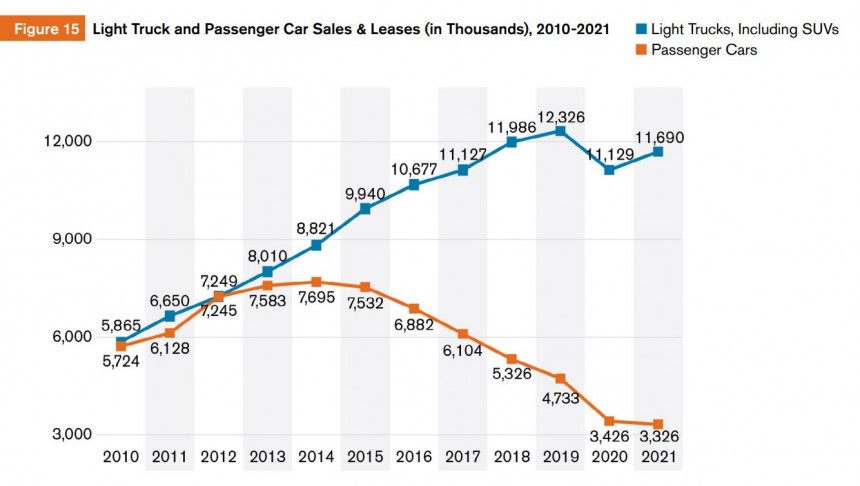Compared to a normal car, an SUV or a truck is safer for its occupants because it’s bigger. That means it can better dissipate the crash energy, so people have a better chance of survival. But when such a big and heavy car SUV or truck strikes a pedestrian, his or her chances of survival are much lower than in the case of a normal car. It’s only logical.
But for now, I have a sort-of-illogical question for you: do you remember the Covid-19 pandemic? Of course, you do. Why do I bring the pandemic into the discussion? Because it had another side effect which concerns a lot of people driving or walking.
As you can see, between 2003 and 2022, in a 10-year span, traffic fatalities in the US grew by 30.1%! There was a spike in 2015 and 2016, and then, for three years in a row, the numbers went down slightly. Unfortunately, 2020 saw another big spike (especially in the second and third quarters), and the post-Covid 2021 broke all the optimism when traffic fatalities passed the 42,000 mark.
Statistics clearly show us the numbers but don’t tell the whole story. Experts agree that, due to the hard times, there were more irresponsible drivers, more dangerous driving situations, and, consequently, more traffic accidents.
Add to the recipe the fast-growing sales of SUVs and trucks, which, by the way, have a weird psychological effect: many drivers feel not only safer but mainly indestructible. Thus, they tend to drive more recklessly or adopt dangerous behavior on the road. There are plenty of videos on YouTube supporting this statement.
However, there is someone concerned solely about pedestrians who are victims of car crashes, and this is the GHSA (Governors Highway Safety Association). It compiled information reported by US states and concluded that in 2022 there were around 7,500 pedestrians killed in traffic crashes. This is 17% of all the traffic fatalities recorded in 2022.
But most of all, GHSA is warning that it’s “the highest number of pedestrian death since 1981.” Besides, the number of pedestrian deaths and their percentage of all traffic fatalities are on the rise. To understand how grim the picture is, you should know that while traffic fatalities grew by 30% in a decade, pedestrian fatalities grew by 77%!
Sint 2010, fatal crashes in the nighttime have increased by 86%, while daytime fatal crashes increased only by 31%. It's interesting to note that three-quarters of crashes killing pedestrians happen in the nighttime. Also, more than two-thirds of pedestrian fatalities are recorded in locations without sidewalks.
Now, imagine you’re in a big car, driving at night, when visibility is much lower, and there’s a big chance that you’re tired and your reflexes are slower. Suddenly there’s some shadow briefly appearing in the far-right corner of your SUV. In a fraction of a second, your brain should understand that there’s a pedestrian on the road (because a sidewalk is missing…), and then command your hands to steer and avoid hitting that person on foot.
You’ll most likely react just after you hit the unfortunate pedestrian. Just think about it.
Let’s not forget the speed factor. While less than 10% of pedestrian fatalities are due to speeding drivers, their number steadily increased compared to the pre-pandemic period. This only supports the observation that the pandemic period led to more reckless drivers on the streets. To put things in perspective, the faster a vehicle travels, the greater the risk of death for pedestrians. In fact, the average risk of death increases exponentially: at 23 mph, it is 10%, while at 58 mph, it goes way up to 90%.
“Every day, 20 people go for a walk and do not return home”
This is how GHSA Chief Executive Officer Jonathan Adkins summarizes the tragic trend. In the last decade, the progress made in the previous three decades was simply erased. Today, even more pedestrians are killed in car crashes than in the ‘80s. This is odd because in the 2020s, cars are much safer for non-occupants, and infrastructure is much more improved.
Or is it? The latest data shows that almost two-thirds of pedestrian fatalities occur on non-freeway arterials. By definition, this type of road is comprised of “high-capacity roads without controlled access but with more traffic flow and higher speeds than local roads”. These are the most dangerous places, because pedestrians interact with high-speeding vehicles.
Statistics reveal something unexpected: for example, in 2021, around 1,300 pedestrians killed on interstates and freeways weren’t walkers. They were drivers exiting their stranded vehicles, first responders like policemen, firemen or doctors, tow truck drivers, or construction workers. This raises a serious question on how effective preventive measures are nowadays on high-speed roads.
How about SUVs and trucks? The truth is that more pedestrians are killed by cars than by SUVs or trucks. But – and this is a big but – the pandemic marked a spike in fatalities caused by bigger vehicles. In the past ten years, the number of pedestrians killed by cars grew by 26%, while the number of those killed by SUVs and trucks increased by 120%.
And at some point in the next few years, there is a high probability that SUVs and trucks will become the enemy no. 1 of pedestrians. It’s simple arithmetic: light trucks (including SUVs) sales and leases are almost four times higher than those for normal cars. For example, in 2021, light trucks accounted for 78% (!) of total vehicle sales.
This is one of the main reasons NHTSA proposed that beginning in 2026 or 2027, all new light vehicles, including SUVs and trucks weighing 10,000 pounds or less, should be equipped with automatic emergency braking systems, including pedestrian detection.
So, there you are: in 2021 and 2022, there were almost 43,000 traffic fatalities, of which around 7,500 (17%) were pedestrians. Compared to 2010, it’s a 30% increase in total traffic fatalities and an incredible 77% surge in pedestrian killings.
These tragic numbers made NHTSA develop a new National Roadway Safety Strategy, which will benefit from unprecedented funding of around $800 million. Will it be enough to address and solve the US roadway safety problem? We hope so. In the meantime, watch out for the SUVs and trucks. Their number is growing. And so is the risk you’d get hit by one of them.
Traffic fatalities were on the rise during the lockdown years
Personal transportation suddenly became the safest mean of transportation in 2020. Safest for those who didn’t want to risk contracting Covid-19 in subs, buses, or airplanes. But as more people were using more cars, the number of car accidents was also increasing. And by a large margin, as you can see in the evolution of traffic fatalities in the last decade, compiled by NHTSA:Statistics clearly show us the numbers but don’t tell the whole story. Experts agree that, due to the hard times, there were more irresponsible drivers, more dangerous driving situations, and, consequently, more traffic accidents.
Add to the recipe the fast-growing sales of SUVs and trucks, which, by the way, have a weird psychological effect: many drivers feel not only safer but mainly indestructible. Thus, they tend to drive more recklessly or adopt dangerous behavior on the road. There are plenty of videos on YouTube supporting this statement.
Pedestrians killed in car crashes are much more than a decade ago
NHTSA defines a traffic fatality as “a crash involving a motor vehicle traveling on a traffic way and resulting in the death of at least one person (occupant of a vehicle or nonoccupant) within 30 days of the crash.” Whether you’re the driver, passenger, pedestrian, or biker doesn't matter. If you were involved in a car crash and died, you become a number in NHTSA traffic fatalities statistics.However, there is someone concerned solely about pedestrians who are victims of car crashes, and this is the GHSA (Governors Highway Safety Association). It compiled information reported by US states and concluded that in 2022 there were around 7,500 pedestrians killed in traffic crashes. This is 17% of all the traffic fatalities recorded in 2022.
But most of all, GHSA is warning that it’s “the highest number of pedestrian death since 1981.” Besides, the number of pedestrian deaths and their percentage of all traffic fatalities are on the rise. To understand how grim the picture is, you should know that while traffic fatalities grew by 30% in a decade, pedestrian fatalities grew by 77%!
Now, imagine you’re in a big car, driving at night, when visibility is much lower, and there’s a big chance that you’re tired and your reflexes are slower. Suddenly there’s some shadow briefly appearing in the far-right corner of your SUV. In a fraction of a second, your brain should understand that there’s a pedestrian on the road (because a sidewalk is missing…), and then command your hands to steer and avoid hitting that person on foot.
You’ll most likely react just after you hit the unfortunate pedestrian. Just think about it.
“Every day, 20 people go for a walk and do not return home”
This is how GHSA Chief Executive Officer Jonathan Adkins summarizes the tragic trend. In the last decade, the progress made in the previous three decades was simply erased. Today, even more pedestrians are killed in car crashes than in the ‘80s. This is odd because in the 2020s, cars are much safer for non-occupants, and infrastructure is much more improved.
Or is it? The latest data shows that almost two-thirds of pedestrian fatalities occur on non-freeway arterials. By definition, this type of road is comprised of “high-capacity roads without controlled access but with more traffic flow and higher speeds than local roads”. These are the most dangerous places, because pedestrians interact with high-speeding vehicles.
How about SUVs and trucks? The truth is that more pedestrians are killed by cars than by SUVs or trucks. But – and this is a big but – the pandemic marked a spike in fatalities caused by bigger vehicles. In the past ten years, the number of pedestrians killed by cars grew by 26%, while the number of those killed by SUVs and trucks increased by 120%.
This is one of the main reasons NHTSA proposed that beginning in 2026 or 2027, all new light vehicles, including SUVs and trucks weighing 10,000 pounds or less, should be equipped with automatic emergency braking systems, including pedestrian detection.
These tragic numbers made NHTSA develop a new National Roadway Safety Strategy, which will benefit from unprecedented funding of around $800 million. Will it be enough to address and solve the US roadway safety problem? We hope so. In the meantime, watch out for the SUVs and trucks. Their number is growing. And so is the risk you’d get hit by one of them.
